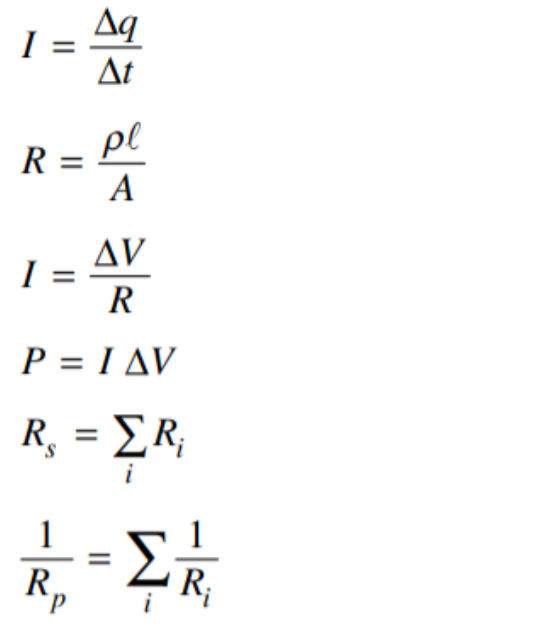
Unit 9 Overview: DC Circuits
1 min read•march 10, 2023
Peter Apps
Peter Apps
Electricity is everywhere, powering our daily lives. Most electronic devices, from cell phones and computers to flashlights and cars use direct current (DC) electrical circuits to power them.

Image courtesy of Unsplash.
This unit serves looks at the concepts from Unit 8 and apply them in creating and analyzing electric circuits. These topics will account for ~6-8% of the AP exam questions and will take approximately 9-12 45 minute class periods to cover.
Applicable Big Ideas
Big Idea #1: Systems - Objects and systems have properties such as mass and charge. Systems may have an internal structure.
Big Idea #5: Conservation - Changes that occur as a result of interactions are constrained by conservation laws.
Key Concepts 🔑
Resistivity (𝜌)
Resistance (R)
Voltage (V)
Current (I)
Charge (q)
Electrical Power (P)
Key Equations 🗝

🎥Watch: AP Physics 1 - Unit 9 Streams
Key Terms to Review (9)
Charge
: Charge refers to an intrinsic property of matter that determines how it interacts with electromagnetic fields. It can be positive or negative, and like charges repel while opposite charges attract each other.Current
: Current refers to the flow of electric charge in a circuit. It is measured in amperes (A) and represents the rate at which charges move through a conductor.Electrical Energy
: Electrical energy refers to the movement of electric charges through a conductor, resulting in the transfer or conversion of electrical power. It is commonly used for powering devices and systems.Electrical Power
: Electrical power refers to the rate at which electrical energy is transferred or consumed in a circuit. It is measured in watts (W) and can be calculated by multiplying the voltage (V) across a device by the current (I) flowing through it.Parallel Circuits
: Parallel circuits are circuits where components are connected across multiple paths. In parallel circuits, the voltage across each component is the same, and adding resistors decreases total resistance.Resistance
: Resistance refers to how much an object or material hinders or opposes the flow of electric current passing through it. It depends on factors such as resistivity and physical dimensions (length and cross-sectional area).Resistivity
: Resistivity is a measure of how strongly a material opposes the flow of electric current. It depends on the material's intrinsic properties, such as its composition and temperature.Series Circuits
: Series circuits are circuits where all components are connected one after another along a single path. In series circuits, the same current flows through each component, and adding resistors increases total resistance.Voltage
: Voltage, also known as electric potential difference, is the measure of electrical potential energy per unit charge. It represents the force that drives electric current through a circuit.Unit 9 Overview: DC Circuits
1 min read•march 10, 2023
Peter Apps
Peter Apps
Electricity is everywhere, powering our daily lives. Most electronic devices, from cell phones and computers to flashlights and cars use direct current (DC) electrical circuits to power them.

Image courtesy of Unsplash.
This unit serves looks at the concepts from Unit 8 and apply them in creating and analyzing electric circuits. These topics will account for ~6-8% of the AP exam questions and will take approximately 9-12 45 minute class periods to cover.
Applicable Big Ideas
Big Idea #1: Systems - Objects and systems have properties such as mass and charge. Systems may have an internal structure.
Big Idea #5: Conservation - Changes that occur as a result of interactions are constrained by conservation laws.
Key Concepts 🔑
Resistivity (𝜌)
Resistance (R)
Voltage (V)
Current (I)
Charge (q)
Electrical Power (P)
Key Equations 🗝

🎥Watch: AP Physics 1 - Unit 9 Streams
Key Terms to Review (9)
Charge
: Charge refers to an intrinsic property of matter that determines how it interacts with electromagnetic fields. It can be positive or negative, and like charges repel while opposite charges attract each other.Current
: Current refers to the flow of electric charge in a circuit. It is measured in amperes (A) and represents the rate at which charges move through a conductor.Electrical Energy
: Electrical energy refers to the movement of electric charges through a conductor, resulting in the transfer or conversion of electrical power. It is commonly used for powering devices and systems.Electrical Power
: Electrical power refers to the rate at which electrical energy is transferred or consumed in a circuit. It is measured in watts (W) and can be calculated by multiplying the voltage (V) across a device by the current (I) flowing through it.Parallel Circuits
: Parallel circuits are circuits where components are connected across multiple paths. In parallel circuits, the voltage across each component is the same, and adding resistors decreases total resistance.Resistance
: Resistance refers to how much an object or material hinders or opposes the flow of electric current passing through it. It depends on factors such as resistivity and physical dimensions (length and cross-sectional area).Resistivity
: Resistivity is a measure of how strongly a material opposes the flow of electric current. It depends on the material's intrinsic properties, such as its composition and temperature.Series Circuits
: Series circuits are circuits where all components are connected one after another along a single path. In series circuits, the same current flows through each component, and adding resistors increases total resistance.Voltage
: Voltage, also known as electric potential difference, is the measure of electrical potential energy per unit charge. It represents the force that drives electric current through a circuit.
Resources
© 2024 Fiveable Inc. All rights reserved.
AP® and SAT® are trademarks registered by the College Board, which is not affiliated with, and does not endorse this website.